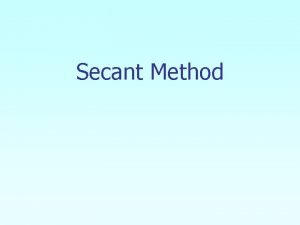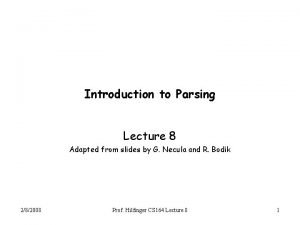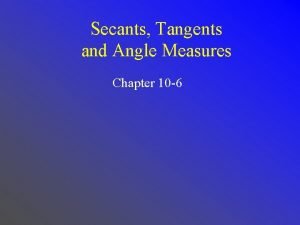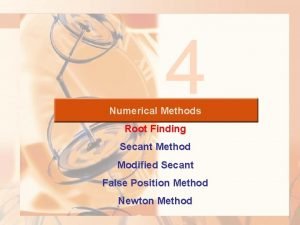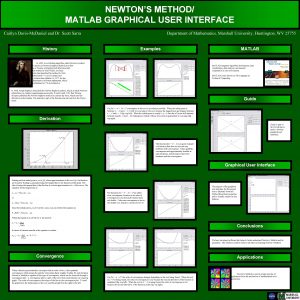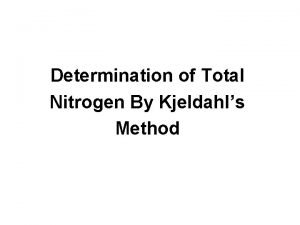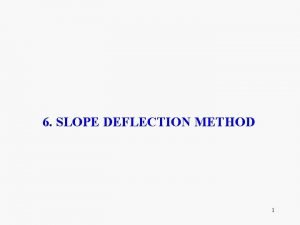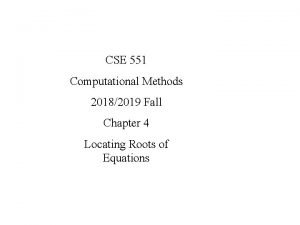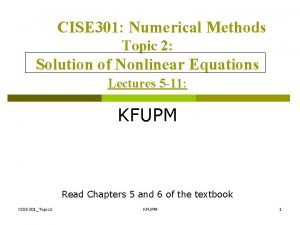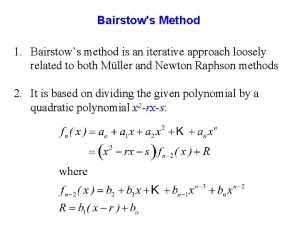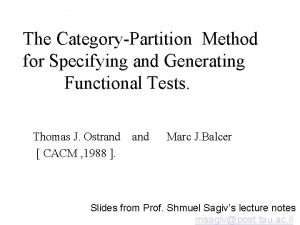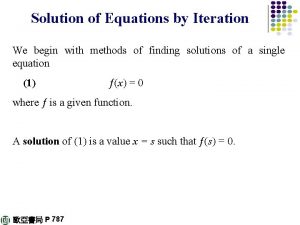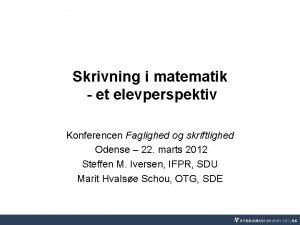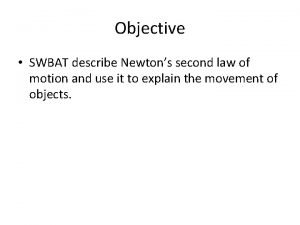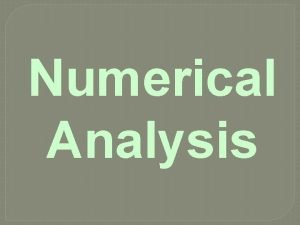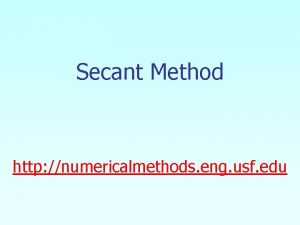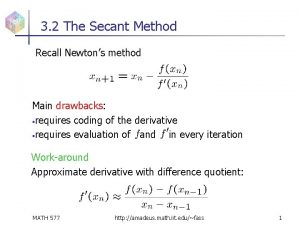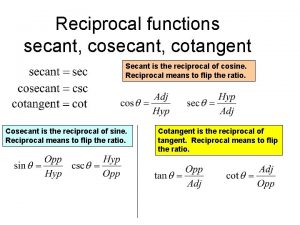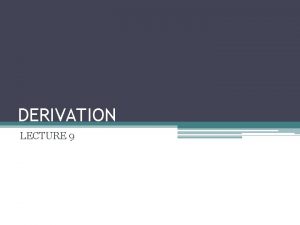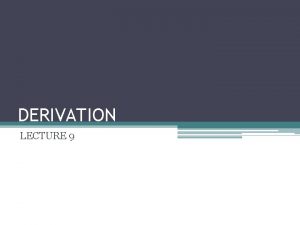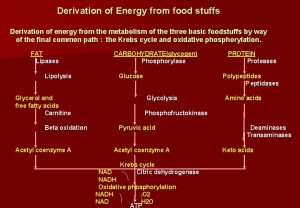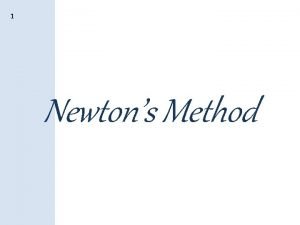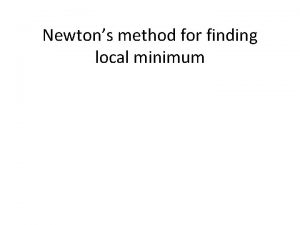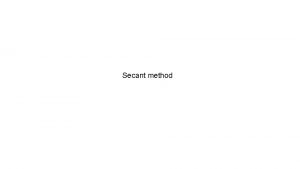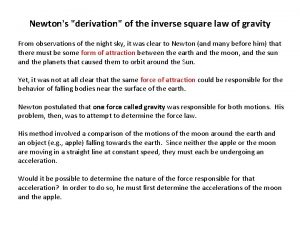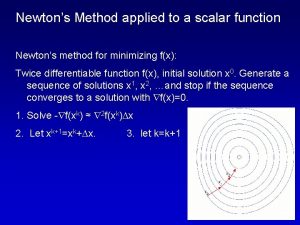Secant Method Secant Method Derivation Newtons Method 1





















- Slides: 21

Secant Method

Secant Method – Derivation Newton’s Method (1) Approximate the derivative (2) Substituting Equation (2) into Equation (1) gives the Secant method Figure 1 Geometrical illustration of the Newton-Raphson method. 2

Secant Method – Derivation The secant method can also be derived from geometry: The Geometric Similar Triangles can be written as On rearranging, the secant method is given as Figure 2 Geometrical representation of the Secant method. 3

Algorithm for Secant Method 4

Step 1 Calculate the next estimate of the root from two initial guesses Find the absolute relative approximate error 5

Step 2 Find if the absolute relative approximate error is greater than the prespecified relative error tolerance. If so, go back to step 1, else stop the algorithm. Also check if the number of iterations has exceeded the maximum number of iterations. 6

Example 1 You are working for ‘DOWN THE TOILET COMPANY’ that makes floats for ABC commodes. The floating ball has a specific gravity of 0. 6 and has a radius of 5. 5 cm. You are asked to find the depth to which the ball is submerged when floating in water. Figure 3 Floating Ball Problem. 7

Example 1 Cont. The equation that gives the depth x to which the ball is submerged under water is given by Use the Secant method of finding roots of equations to find the depth x to which the ball is submerged under water. • Conduct three iterations to estimate the root of the above equation. • Find the absolute relative approximate error and the number of significant digits at least correct at the end of each iteration. 8

Example 1 Cont. Solution To aid in the understanding of how this method works to find the root of an equation, the graph of f(x) is shown to the right, where Figure 4 Graph of the function f(x). 9

Example 1 Cont. Let us assume the initial guesses of the root of as and Iteration 1 The estimate of the root is 10 lmethods. eng. usf. edu ht

Example 1 Cont. The absolute relative approximate error Iteration 1 is at the end of The number of significant digits at least correct is 0, as you need an absolute relative approximate error of 5% or less for one significant digits to be correct in your result. 11

Example 1 Cont. Figure 5 Graph of results of Iteration 1. 12

Example 1 Cont. Iteration 2 The estimate of the root is 13

Example 1 Cont. The absolute relative approximate error Iteration 2 is at the end of The number of significant digits at least correct is 1, as you need an absolute relative approximate error of 5% or less. 14

Example 1 Cont. Figure 6 Graph of results of Iteration 2. 15 lmethods. eng. usf. edu ht

Example 1 Cont. Iteration 3 The estimate of the root is 16

Example 1 Cont. The absolute relative approximate error Iteration 3 is at the end of The number of significant digits at least correct is 5, as you need an absolute relative approximate error of 0. 5% or less. 17

Iteration #3 Figure 7 Graph of results of Iteration 3. 18

Advantages n n 19 Converges fast, if it converges Requires two guesses that do not need to bracket the root

Drawbacks Division by zero 20

Drawbacks (continued) Root Jumping 21
 Secant method
Secant method Leftmost derivation and rightmost derivation
Leftmost derivation and rightmost derivation Angle formed by tangent and secant
Angle formed by tangent and secant Secant method numerical method
Secant method numerical method Newtons method matlab
Newtons method matlab Dumas method formula
Dumas method formula Slope deflection method definition
Slope deflection method definition Newton raphson method
Newton raphson method Secant method pseudocode
Secant method pseudocode Cise flowchart
Cise flowchart Bairstow algorithm
Bairstow algorithm Secant method matlab
Secant method matlab Secant method شرح
Secant method شرح Secant method examples
Secant method examples Secant method nonlinear equations
Secant method nonlinear equations Matematik
Matematik Newtons 3 rd law of motion
Newtons 3 rd law of motion Inertia in soccer
Inertia in soccer Scope of personal selling
Scope of personal selling Describe newtons second law
Describe newtons second law Newton backward interpolation formula
Newton backward interpolation formula Example of newton's first law
Example of newton's first law
